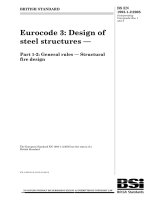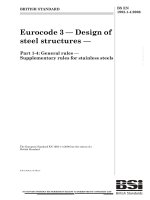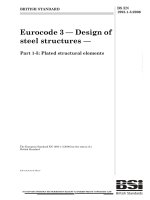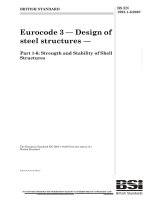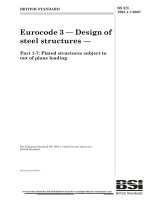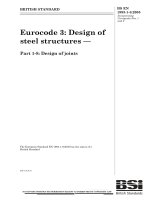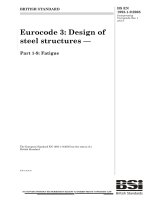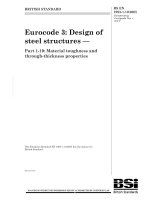Tiêu chuẩn Châu Âu EC7: Kết cấu nền móng phần 1.2: Khảo sát và thí nghiệm (Eurocode7 BS EN1997 2 e 2007 Geotechnicl desgn part 1.2: Ground investigation and testing)
Bạn đang xem bản rút gọn của tài liệu. Xem và tải ngay bản đầy đủ của tài liệu tại đây (1.74 MB, 202 trang )
BRITISH STANDARD
Eurocode 7 —
Geotechnical design —
Licensed copy:SKM Anthony Hunt, 07/03/2008, Uncontrolled Copy, © BSI
Part 2: Ground investigation and
testing
The European Standard EN 1997-2:2007 has the status of a
British Standard
ICS 91.060.01; 91.120.20
12 &23<,1* :,7+287 %6, 3(50,66,21 (;&(37 $6 3(50,77(' %< &23<5,*+7 /$:
BS EN
1997-2:2007
BS EN 1997-2:2007
Licensed copy:SKM Anthony Hunt, 07/03/2008, Uncontrolled Copy, © BSI
National foreword
This British Standard was published by BSI. It is the UK implementation of
EN 1997-2:2007. It supersedes DD ENV 1997-2:2000 and DD ENV 1997-3:2000
which are withdrawn. It partially supersedes BS 5930:1999 and
BS 1377-9:1990.
The structural Eurocodes are divided into packages by grouping Eurocodes for
each of the main materials: concrete, steel, composite concrete and steel,
timber, masonry and aluminium; this is to enable a common date of
withdrawal (DOW) for all the relevant parts that are needed for a particular
design. The conflicting national standards will be withdrawn at the end of the
coexistence period, after all the EN Eurocodes of a package are available.
Following publication of the EN, there is a period allowed for national
calibration during which the National Annex is issued, followed by a
coexistence period of a maximum three years. During the coexistence period
Member States are encouraged to adapt their national provisions. At the end
of this coexistence period, the conflicting parts of national standard(s) will be
withdrawn.
In the UK, the primary corresponding national standard is:
— BS 5930:1999, Code of practice for site investigations
and based on this transition period, this standard will be withdrawn/revised on
a date to be announced, but at the latest by March 2010.
For in-situ testing, the primary test method references in BS EN 1997-2:2007
are to new CEN /ISO standards and this will require the withdrawal of some
sections of BS 1377-9:1990, Methods of test for soils for civil engineering
purposes — In-situ tests, as well as parts of BS 5930:1999 as they are
published.
For laboratory testing, many of the primary test method references in
BS EN 1997-2:2007 are new CEN/ISO technical specifications. These will not
be adopted in the UK and the standards below will continue to be the preferred
standards.
— BS 1377-1:1990, Methods of test for soils for civil engineering purposes –
General requirements and sample preparation
— BS 1377-2:1990, Methods of test for soils for civil engineering purposes –
Classification tests
— BS 1377-3:1990, Methods of test for soils for civil engineering purposes –
Chemical and electro-chemical tests
— BS 1377-4:1990, Methods of test for soils for civil engineering purposes –
Compaction-related tests
— BS 1377-5:1990, Methods of test for soils for civil engineering purposes –
Compressibility, permeability and durability tests
— BS 1377-6:1990, Methods of test for soils for civil engineering purposes –
Consolidation and permeability tests in hydraulic cells and with pore
pressure measurement
— BS 1377-7:1990, Methods of test for soils for civil engineering purposes –
Shear strength tests (total stress)
— BS 1377-8:1990, Methods of test for soils for civil engineering purposes –
Shear strength tests (effective stress)
This British Standard was
published under the authority
of the Standards Policy and
Strategy Committee
on 30 April 2007
© BSI 2007
ISBN 978 0 580 50569 0
Amendments issued since publication
Amd. No.
Date
Comments
BS EN 1997-2:2007
Further guidance will be given in the National Annex to EN 1997-2.
The UK participation in its preparation was entrusted to Technical Committee
B/526, Geotechnics.
A list of organizations represented on this committee can be obtained on request
to its secretary.
Where a normative part of this EN allows for a choice to be made at the national
level, the range and possible choice will be given in the normative text, and a note
will qualify it as a Nationally Determined Parameter (NDP). NDPs can be a
specific value for a factor, a specific level or class, a particular method or a
particular application rule if several are proposed in the EN.
To enable EN 1997-2 to be used in the UK, the NDPs will be published in a
National Annex, which will be made available by BSI in due course, after public
consultation has taken place.
This publication does not purport to include all the necessary provisions of a
contract. Users are responsible for its correct application.
Licensed copy:SKM Anthony Hunt, 07/03/2008, Uncontrolled Copy, © BSI
Compliance with a British Standard cannot confer immunity from legal
obligations.
i
Licensed copy:SKM Anthony Hunt, 07/03/2008, Uncontrolled Copy, © BSI
blank
EUROPEAN STANDARD
EN 1997-2
NORME EUROPÉENNE
EUROPÄISCHE NORM
March 2007
ICS 91.060.01; 91.120.20
Supersedes ENV 1997-2:1999, ENV 1997-3:1999
English Version
Eurocode 7 - Geotechnical design - Part 2: Ground investigation
and testing
Eurocode 7 - Calcul géotechnique - Partie 2:
Reconnaissance des terrains et essais
Eurocode 7 - Entwurf, Berechnung und Bemessung in der
Geotechnik - Teil 2: Erkundung und Untersuchung des
Baugrunds
Licensed copy:SKM Anthony Hunt, 07/03/2008, Uncontrolled Copy, © BSI
This European Standard was approved by CEN on 12 June 2006.
CEN members are bound to comply with the CEN/CENELEC Internal Regulations which stipulate the conditions for giving this European
Standard the status of a national standard without any alteration. Up-to-date lists and bibliographical references concerning such national
standards may be obtained on application to the CEN Management Centre or to any CEN member.
This European Standard exists in three official versions (English, French, German). A version in any other language made by translation
under the responsibility of a CEN member into its own language and notified to the CEN Management Centre has the same status as the
official versions.
CEN members are the national standards bodies of Austria, Belgium, Bulgaria, Cyprus, Czech Republic, Denmark, Estonia, Finland,
France, Germany, Greece, Hungary, Iceland, Ireland, Italy, Latvia, Lithuania, Luxembourg, Malta, Netherlands, Norway, Poland, Portugal,
Romania, Slovakia, Slovenia, Spain, Sweden, Switzerland and United Kingdom.
EUROPEAN COMMITTEE FOR STANDARDIZATION
COMITÉ EUROPÉEN DE NORMALISATION
EUROPÄISCHES KOMITEE FÜR NORMUNG
Management Centre: rue de Stassart, 36
© 2007 CEN
All rights of exploitation in any form and by any means reserved
worldwide for CEN national Members.
B-1050 Brussels
Ref. No. EN 1997-2:2007: E
EN 1997-2:2007 (E)
Contents .............................................................................................................................. Page
Foreword .................................................................................................................................... 7
Licensed copy:SKM Anthony Hunt, 07/03/2008, Uncontrolled Copy, © BSI
Section 1 General.................................................................................................................... 10
1.1 Scope ................................................................................................................................ 10
1.1.1 Scope of Eurocode 7 ................................................................................................... 10
1.1.2 Scope of EN 1997-2.................................................................................................... 10
1.2 Normative references........................................................................................................ 11
1.3 Assumptions ..................................................................................................................... 12
1.4 Distinction between Principles and Application Rules .................................................... 12
1.5 Definitions ........................................................................................................................ 13
1.5.1 Terms common to all Eurocodes ................................................................................ 13
1.5.2 Terms common to Eurocode 7 .................................................................................... 13
1.5.3 Specific definitions used in EN 1997-2 ...................................................................... 13
1.6 Test results and derived values ......................................................................................... 14
1.7 The link between EN 1997-1 and EN 1997-2 .................................................................. 15
Section 2 Planning of ground investigations ........................................................................ 20
2.1 Objectives ......................................................................................................................... 20
2.1.1 General ........................................................................................................................ 20
2.1.2 Ground ........................................................................................................................ 21
2.1.3 Construction materials ................................................................................................ 22
2.1.4 Groundwater ............................................................................................................... 22
2.2 Sequence of ground investigations ................................................................................... 22
2.3 Preliminary investigations ................................................................................................ 23
2.4 Design investigations........................................................................................................ 24
2.4.1 Field investigations ..................................................................................................... 24
2.4.2 Laboratory tests........................................................................................................... 27
2.5 Controlling and monitoring .............................................................................................. 31
Section 3 Soil and rock sampling and groundwater measurements .................................. 33
3.1 General.............................................................................................................................. 33
3.2 Sampling by drilling ......................................................................................................... 33
3.3 Sampling by excavation.................................................................................................... 33
3.4 Soil sampling .................................................................................................................... 33
3.4.1 Categories of sampling methods and laboratory quality classes of samples .............. 33
3.4.2 Soil identification........................................................................................................ 34
3.4.3 Planning of soil sampling............................................................................................ 34
3.4.4 Handling, transport and storing of samples ................................................................ 35
3.5 Rock sampling .................................................................................................................. 35
3.5.1 Categories of sampling methods ................................................................................. 35
3.5.2 Rock identification...................................................................................................... 36
3.5.3 Planning of rock sampling .......................................................................................... 36
3.5.4 Handling, transport and storing of samples ................................................................ 37
3.6 Groundwater measurements in soils and rocks ................................................................ 37
3.6.1 General ........................................................................................................................ 37
3.6.2 Planning and execution of the measurements ............................................................. 37
3.6.3 Evaluation of results of groundwater measurements .................................................. 38
2
Licensed copy:SKM Anthony Hunt, 07/03/2008, Uncontrolled Copy, © BSI
EN 1997-2:2007 (E)
Section 4 Field tests in soil and rock ..................................................................................... 40
4.1 General.............................................................................................................................. 40
4.2 General requirements........................................................................................................ 40
4.2.1 Planning a specific test programme ............................................................................ 40
4.2.2 Execution .................................................................................................................... 41
4.2.3 Evaluation ................................................................................................................... 41
4.3 Cone penetration and piezocone penetration tests (CPT, CPTU)..................................... 42
4.3.1 Objectives ................................................................................................................... 42
4.3.2 Specific requirements.................................................................................................. 42
4.3.3 Evaluation of test results............................................................................................. 43
4.3.4 Use of test results and derived values ......................................................................... 43
4.4 Pressuremeter tests (PMT)................................................................................................ 45
4.4.1 Objectives ................................................................................................................... 45
4.4.2 Specific requirements.................................................................................................. 45
4.4.3 Evaluation of test results............................................................................................. 46
4.4.4 Use of test results and derived values ......................................................................... 47
4.5 Flexible dilatometer test (FDT) ........................................................................................ 48
4.5.1 Objectives ................................................................................................................... 48
4.5.2 Specific requirements.................................................................................................. 48
4.5.3 Evaluation of test results............................................................................................. 48
4.5.4 Use of test results and derived values ......................................................................... 49
4.6 Standard penetration test (SPT)........................................................................................ 49
4.6.1 Objectives ................................................................................................................... 49
4.6.2 Specific requirements.................................................................................................. 49
4.6.3 Evaluation of test results............................................................................................. 49
4.6.4 Use of test results and derived values ......................................................................... 50
4.7 Dynamic probing tests (DP) ............................................................................................. 51
4.7.1 Objectives ................................................................................................................... 51
4.7.2 Specific requirements.................................................................................................. 52
4.7.3 Evaluation of test results............................................................................................. 52
4.7.4 Use of test results and derived values ......................................................................... 52
4.8 Weight sounding test (WST) ............................................................................................ 53
4.8.1 Objectives ................................................................................................................... 53
4.8.2 Specific requirements.................................................................................................. 53
4.8.3 Evaluation of test results............................................................................................. 54
4.8.4 Use of test results and derived values ......................................................................... 54
4.9 Field vane test (FVT)........................................................................................................ 55
4.9.1 Objectives ................................................................................................................... 55
4.9.2 Specific requirements.................................................................................................. 55
4.9.3 Evaluation of test results............................................................................................. 55
4.9.4 Use of test results and derived values ......................................................................... 55
4.10 Flat dilatometer test (DMT)............................................................................................ 56
4.10.1 Objectives ................................................................................................................. 56
4.10.2 Specific requirements................................................................................................ 56
4.10.3 Evaluation of test results ........................................................................................... 56
4.10.4 Use of test results and derived values ....................................................................... 57
4.11 Plate loading test (PLT) .................................................................................................. 57
4.11.1 Objectives ................................................................................................................. 57
4.11.2 Specific requirements................................................................................................ 58
4.11.3 Evaluation of test results ........................................................................................... 58
4.11.4 Use of test results and derived values ....................................................................... 58
3
Licensed copy:SKM Anthony Hunt, 07/03/2008, Uncontrolled Copy, © BSI
EN 1997-2:2007 (E)
Section 5 Laboratory tests on soil and rock ......................................................................... 60
5.1 General.............................................................................................................................. 60
5.2 General requirements for laboratory tests ........................................................................ 60
5.2.1.General requirements .................................................................................................. 60
5.2.2 Procedures, equipment and presentation..................................................................... 60
5.2.3 Evaluation of test results............................................................................................. 60
5.3 Preparation of soil specimens for testing.......................................................................... 61
5.3.1 Objective ..................................................................................................................... 61
5.3.2 Requirements .............................................................................................................. 61
5.4 Preparation of rock specimens for testing ........................................................................ 62
5.4.1 Objective ..................................................................................................................... 62
5.4.2 Requirements .............................................................................................................. 62
5.5 Tests for classification, identification and description of soil .......................................... 63
5.5.1 General ........................................................................................................................ 63
5.5.2 Requirements for all classification tests ..................................................................... 63
5.5.3 Water content determination....................................................................................... 63
5.5.4 Bulk density determination ......................................................................................... 64
5.5.5 Particle density determination..................................................................................... 64
5.5.6 Particle size analysis ................................................................................................... 64
5.5.7 Consistency limits determination................................................................................ 65
5.5.8 Determination of the density index of granular soil ................................................... 66
5.5.9 Soil dispersibility determination ................................................................................. 67
5.5.10 Frost susceptibility .................................................................................................... 68
5.6 Chemical testing of soil and groundwater ........................................................................ 68
5.6.1 Requirements for all chemical tests ............................................................................ 68
5.6.2 Organic content determination.................................................................................... 70
5.6.3 Carbonate content determination ................................................................................ 71
5.6.4 Sulfate content determination ..................................................................................... 71
5.6.5 pH value determination (acidity and alkalinity) ......................................................... 72
5.6.6 Chloride content determination................................................................................... 72
5.7 Strength index testing of soil ............................................................................................ 73
5.7.1 Objective ..................................................................................................................... 73
5.7.2 Requirements .............................................................................................................. 73
5.7..3 Use of test results ....................................................................................................... 73
5.8 Strength testing of soil...................................................................................................... 73
5.8.1 Objective and scope .................................................................................................... 73
5.8.2 General requirements .................................................................................................. 74
5.8.3 Evaluation and use of test results................................................................................ 75
5.8.4 Unconfined compression test...................................................................................... 75
5.8.5 Unconsolidated, undrained triaxial compression test ................................................. 76
5.8.6 Consolidated triaxial compression test ....................................................................... 76
5.8.7 Consolidated direct shear box tests............................................................................. 77
5.9 Compressibility and deformation testing of soil............................................................... 78
5.9.1 General ........................................................................................................................ 78
5.9.2 Oedometer compressibility testing ............................................................................. 78
5.9.3 Triaxial deformability testing ..................................................................................... 80
5.10 Compaction testing of soil.............................................................................................. 81
5.10.1 Scope......................................................................................................................... 81
5.10.2 Compaction tests....................................................................................................... 81
5.10.3 California Bearing ratio (CBR) test .......................................................................... 81
4
Licensed copy:SKM Anthony Hunt, 07/03/2008, Uncontrolled Copy, © BSI
EN 1997-2:2007 (E)
5.11 Permeability testing of soil ............................................................................................. 82
5.11.1 Objective ................................................................................................................... 82
5.11.2 Requirements ............................................................................................................ 82
5.11.3 Evaluation and use of test results.............................................................................. 83
5.12 Tests for classification of rocks ...................................................................................... 84
5.12.1 General ...................................................................................................................... 84
5.12.2 Requirements for all classification tests ................................................................... 84
5.12.3 Rock identification and description .......................................................................... 84
5.12.4 Water content determination..................................................................................... 85
5.12.5 Density and porosity determination .......................................................................... 86
5.13 Swelling testing of rock material.................................................................................... 86
5.13.1 General ...................................................................................................................... 86
5.13.2 General requirements ................................................................................................ 87
5.13.3 Evaluation of test results ........................................................................................... 87
5.13.4 Swelling pressure index under zero volume change................................................. 87
5.13.5 Swelling strain index for radially-confined specimens with axial surcharge ........... 88
5.13.6 Swelling strain developed in unconfined rock specimen.......................................... 89
5.14 Strength testing of rock material .................................................................................... 89
5.14.1 General ...................................................................................................................... 89
5.14.2 Requirements for all strength tests............................................................................ 89
5.14.3 Evaluation of test results ........................................................................................... 90
5.14.4 Uniaxial compression and deformability test ........................................................... 90
5.14.5 Point load test............................................................................................................ 91
5.14.6 Direct shear test......................................................................................................... 92
5.14.7 Brazil test .................................................................................................................. 93
5.14.8 Triaxial compression test .......................................................................................... 94
Section 6 Ground investigation report ................................................................................. 95
6.1 General requirements........................................................................................................ 95
6.2 Presentation of geotechnical information ......................................................................... 95
6.3 Evaluation of geotechnical information ........................................................................... 96
6.4 Establishment of derived values ....................................................................................... 97
Annex A (informative) List of test results of geotechnical test standards.......................... 98
Annex B (informative) Planning of geotechnical investigations ....................................... 101
Annex C (informative) Example of groundwater pressure derivations based
on a model and long term measurements .......................................................... 109
Annex D (informative) Cone and piezocone penetration tests .......................................... 111
Annex E (informative) Pressure meter test ........................................................................ 121
Annex F (informative) Standard penetration test ............................................................. 125
Annex G (informative) Dynamic probing test .................................................................... 129
Annex H (informative) Weight sounding test
134
Annex I (informative) Field vane test................................................................................. 133
Annex J (informative) Flat dilatometer test Example of correlations between EOED
and DMT results .................................................................................................. 138
Annex K (informative) Plate loading test ............................................................................ 139
Annex L (informative) Detailed information on preparation of soil specimens
for testing .............................................................................................................. 143
Annex M (informative) Detailed information on tests for classification, identification
and description of soil.......................................................................................... 150
Annex N (informative) Detailed information on chemical testing of soil......................... 157
5
EN 1997-2:2007 (E)
Licensed copy:SKM Anthony Hunt, 07/03/2008, Uncontrolled Copy, © BSI
Annex O
Annex P
Annex Q
Annex R
Annex S
Annex T
Annex U
Annex V
Annex W
Annex X
6
(informative) Detailed information on strength index testing of soil ............... 162
(informative) Detailed information on strength testing of soil.......................... 163
(informative) Detailed information on compressibility testing of soil.............. 165
(informative) Detailed information on compaction testing of soil .................... 166
(informative) Detailed information on permeability testing of soil .................. 168
(informative) Preparation of specimen for testing on rockmaterial................. 170
(informative) Classification testing of rock material ......................................... 171
(informative) Swelling testing of rock material .................................................. 173
(informative) Strength testing of rock material ................................................. 175
(informative) Bibliography................................................................................... 180
EN 1997-2:2007 (E)
Foreword
This document (EN 1997-2: 2007) has been prepared by Technical Committee CEN/TC 250
"Structural Eurocodes", the secretariat of which is held by BSI.
This European Standard shall be given the status of a national standard, either by publication of
an identical text or by endorsement, at the latest by September 2007, and conflicting national standards
shall be withdrawn at the latest by March 2010.
This document supersedes ENV 1997-2:1999 and ENV 1997-3:1999.
CEN/TC 250 is responsible for all Structural Eurocodes.
Licensed copy:SKM Anthony Hunt, 07/03/2008, Uncontrolled Copy, © BSI
According to the CEN/CENELEC Internal Regulations, the national standards organizations of
the following countries are bound to implement this European Standard: Austria, Belgium, Bulgaria
Cyprus, Czech Republic, Denmark, Estonia, Finland, France, Germany, Greece, Hungary,
Iceland, Ireland, Italy, Latvia, Lithuania, Luxembourg, Malta, Netherlands, Norway, Portugal,
Poland, Romania, Slovakia, Slovenia, Spain, Sweden, Switzerland and the United Kingdom.
Background of the Eurocode programme
In 1975, the Commission of the European Community decided on an action programme in the
field of construction, based on article 95 of the Treaty. The objective of the programme was the
elimination of technical obstacles to trade and the harmonization of technical specifications.
Within this action programme, the Commission took the initiative to establish a set of
harmonised technical rules for the design of construction works, which, in a first stage, would
serve as an alternative to the national rules in force in the Member States and, ultimately, would
replace them.
For fifteen years, the Commission, with the help of a Steering Committee with representatives of
Member States, conducted the development of the Eurocodes programme, which led to the first
generation of European codes in the 1980s.
In 1989, the Commission and the Member States of the EU and EFTA decided, on the basis of
an agreement1 between the Commission and CEN, to transfer the preparation and the publication
of the Eurocodes to CEN through a series of Mandates, in order to provide them with a future
status of European Standard (EN). This links de facto the Eurocodes with the provisions of all
the Council’s Directives and/or Commission’s Decisions dealing with European standards (e.g.
the Council Directive 89/106/EEC on construction products - CPD - and Council Directives
93/37/EEC, 92/50/EEC and 89/440/EEC on public works and services and equivalent EFTA
Directives initiated in pursuit of setting up the internal market).
The Structural Eurocode programme comprises the following standards generally consisting of a
number of Parts:
EN 1990
EN 1991
Eurocode :
Eurocode 1:
Basis of Structural Design
Actions on structures
1 Agreement between the Commission of the European Communities and the European Committee for Standardization (CEN) concerning the
work on EUROCODES for the design of building and civil engineering works (BC/CEN/03/89).
7
EN 1997-2:2007 (E)
EN 1992
EN 1993
EN 1994
EN 1995
EN 1996
EN 1997
EN 1998
EN 1999
Eurocode 2:
Eurocode 3:
Eurocode 4:
Eurocode 5:
Eurocode 6:
Eurocode 7:
Eurocode 8:
Eurocode 9:
Design of concrete structures
Design of steel structures
Design of composite steel and concrete structures
Design of timber structures
Design of masonry structures
Geotechnical design
Design of structures for earthquake resistance
Design of aluminium structures
Eurocode standards recognise the responsibility of regulatory authorities in each Member State
and have safeguarded their right to determine values related to regulatory safety matters at
national level where these continue to vary from State to State.
Licensed copy:SKM Anthony Hunt, 07/03/2008, Uncontrolled Copy, © BSI
Status and field of application of Eurocodes
The Member States of the EU and EFTA recognise that Eurocodes serve as reference documents
for the following purposes:
— as a means to prove compliance of building and civil engineering works with the essential
requirements of Council Directive 89/106/EEC, particularly Essential Requirement N°1 –
Mechanical resistance and stability – and Essential Requirement N°2 – Safety in case of fire;
— as a basis for specifying contracts for construction works and related engineering services;
— as a framework for drawing up harmonised technical specifications for construction products
(ENs and ETAs).
The Eurocodes, as far as they concern the construction works themselves, have a direct
relationship with the Interpretative Documents2 referred to in Article 12 of the CPD, although
they are of a different nature from harmonised product standards3. Therefore, technical aspects
arising from the Eurocodes work need to be adequately considered by CEN Technical
Committees and/or EOTA Working Groups working on product standards with a view to
achieving full compatibility of these technical specifications with the Eurocodes.
The Eurocode standards provide common structural design rules for everyday use for the design
of whole structures and component products of both a traditional and an innovative nature.
Unusual forms of construction or design conditions are not specifically covered and additional
expert consideration will be required by the designer in such cases.
2 According to Art. 3.3 of the CPD, the essential requirements (ERs) shall be given concrete form in interpretative documents for the creation of
the necessary links between the essential requirements and the mandates for harmonised ENs and ETAGs/ETAs.
3 According to Art. 12 of the CPD the interpretative documents shall :
a) give concrete form to the essential requirements by harmonising the terminology and the technical bases and indicating classes or levels
for each requirement where necessary ;
b) indicate methods of correlating these classes or levels of requirement with the technical specifications, e.g. methods of calculation and of
proof, technical rules for project design, etc. ;
c) serve as a reference for the establishment of harmonised standards and guidelines for European technical approvals.
The Eurocodes, de facto, play a similar role in the field of the ER 1 and a part of ER 2.
8
EN 1997-2:2007 (E)
National Standards implementing Eurocodes
The National Standards implementing Eurocodes will comprise the full text of the Eurocode
(including any annexes), as published by CEN, which may be preceded by a National title page
and National foreword, and may be followed by a National annex.
Licensed copy:SKM Anthony Hunt, 07/03/2008, Uncontrolled Copy, © BSI
The National annex may only contain information on those parameters, which are left open in the
Eurocode for national choice, known as Nationally Determined Parameters, to be used for the
design of buildings and civil engineering works to be constructed in the country concerned, i.e.:
− values and/or classes where alternatives are given in the Eurocode;
− values to be used where a symbol only is given in the Eurocode;
− country specific data (geographical, climatic), e.g. snow map;
− the procedure to be used where alternative procedures are given in the Eurocode.
It may also contain:
− decisions on the application of informative annexes;
− references to non-contradictory complementary information to assist the user to apply the
Eurocode.
Links between Eurocodes and harmonised technical specifications (ENs and ETAs) for
products
There is a need for consistency between the harmonised technical specifications for construction
products and the technical rules for works4. Furthermore, all the information accompanying the
CE Marking of the construction products, which refer to Eurocodes, should clearly mention
which Nationally Determined Parameters have been taken into account.
Additional information specific to Eurocode 7
EN 1997-2 gives guidance for the planning and interpretation of geotechnical laboratory and field
tests that are used for the support of geotechnical design of buildings and civil engineering works.
EN 1997-2 is intended for clients, designers, geotechnical laboratories, field testing laboratories
and public authorities.
EN 1997-2 is intended to be used with EN 1997-1.
When using EN 1997-2, particular regard should be paid to the underlying assumptions and
conditions given in 1.3.
The six sections of EN 1997-2 are complemented by 24 informative annexes.
National annex for EN 1997-2
The national standard implementing EN 1997-2 should have a national annex containing all
information concerning the application of EN 1997-2 in the relevant country.
4 See Art.3.3 and Art.12 of the CPD, as well as 4.2, 4.3.1, 4.3.2 and 5.2 of ID 1.
9
EN 1997-2:2007 (E)
Section 1
General
1.1 Scope
1.1.1 Scope of Eurocode 7
(1) EN 1997 is intended to be used in conjunction with EN 1990:2002, which establishes the
principles and requirements for safety and serviceability, describes the basis of design and
verification and gives guidelines for related aspects of structural reliability.
(2) EN 1997 is intended to be applied to the geotechnical aspects of the design of buildings and
civil engineering works. It is subdivided into various separate parts (see 1.1.2).
Licensed copy:SKM Anthony Hunt, 07/03/2008, Uncontrolled Copy, © BSI
(3) EN 1997 is concerned with the requirements for strength, stability, serviceability and
durability of structures. Other requirements, e.g. concerning thermal or sound insulation, are not
considered.
(4) Numerical values of actions on buildings and civil engineering works to be taken into
account in design are provided in EN 1991 for the various types of construction. Actions
imposed by the ground, such as earth pressures, shall be calculated according to the rules of
EN 1997.
(5) Separate European Standards are intended to be used to treat matters of execution and
workmanship. They are denoted in the relevant sections.
(6) In EN 1997 execution is covered to the extent that is necessary to conform to the assumptions
of the design rules.
(7) EN 1997 does not cover the special requirements of seismic design. EN 1998 provides
additional rules for geotechnical seismic design, which complete or adapt the rules of this
standard.
1.1.2 Scope of EN 1997-2
(1) EN 1997-2 is intended to be used in conjunction with EN 1997-1 and provides rules
supplementary to EN 1997-1 related to:
− planning and reporting of ground investigations;
− general requirements for a number of commonly used laboratory and field tests;
− interpretation and evaluation of test results;
− derivation of values of geotechnical parameters and coefficients.
In addition, examples of the application of field test results to design are given.
NOTE
Establishment of characteristic values is covered in EN 1997-1.
(2) This document gives no specific provisions for environmental ground investigations.
(3) Only commonly used geotechnical laboratory and field tests are covered in this standard.
These were selected on the basis of their importance in geotechnical practice, availability in
10
EN 1997-2:2007 (E)
commercial geotechnical laboratories and existence of an accepted testing procedure in Europe.
The laboratory tests on soils are mainly applicable to saturated soils.
NOTE
It is expected that updates of the present standard will gradually include laboratory and field tests
covering additional aspects of soil and rock behaviour.
(4) The provisions of this standard apply primarily to projects of geotechnical category 2, as
defined in 2.1 of EN 1997-1:2004. The ground investigation requirements for category 1 projects
are normally limited as the verifications often will be based on local experience. For
geotechnical category 3 projects, the amount of investigations required will normally be at least
the same as indicated for geotechnical category 2 projects in the following sections. Additional
investigations and more advanced tests, related to the circumstances that place a project in
geotechnical category 3, may be necessary.
(5) The derivation of parameter values is dedicated primarily to the design of pile and spread
foundations based on field testing, as detailed in Annexes D, E, F and G of EN 1997-1:2004.
Licensed copy:SKM Anthony Hunt, 07/03/2008, Uncontrolled Copy, © BSI
1.2 Normative references
(1) The following normative documents contain provisions which, through reference in this text,
constitute provisions of this European Standard. For dated references, subsequent amendments
to, or revisions of, any of these publications do not apply. However, parties to agreements based
on this European Standard are encouraged to investigate the possibility of applying the most
recent editions of the normative documents indicated below. For undated references, the last
edition of the normative document referred to applies.
EN 1990:2002
EN 1997-1:2004
EN ISO 14688-1
EN ISO 14688-2
EN ISO 14689-1
EN ISO 22475-15
EN ISO 22476-15
EN ISO 22476-2
EN ISO 22476-3
EN ISO 22476-45
EN ISO 22476-55
EN ISO 22476-66
Eurocode — Basis of structural design
Eurocode 7 — Geotechnical design — Part 1: General rules
Geotechnical investigation and testing — Identification and classification
of soil — Part 1: Identification and description
Geotechnical investigation and testing — Identification and classification
of soil — Part 2: Classification principles
Geotechnical investigation and testing — Identification and classification
of rock - Part 1: Identification and description
Geotechnical investigation and testing — Sampling by drilling and
excavation and groundwater measurements — Part 1: Technical
principles of execution
Geotechnical investigation and testing — Field testing — Part 1:
Electrical CPT and CPTU
Geotechnical investigation and testing — Field testing — Part 2: Dynamic
probing
Geotechnical investigation and testing — Field testing — Part 3:
Standard penetration test
Geotechnical investigation and testing — Field testing — Part 4: Ménard
pressuremeter test
Geotechnical investigation and testing — Field testing — Part 5: Flexible
dilatometer test
Geotechnical investigation and testing — Field testing — Part 6: Self
boring pressuremeter test
5 to be published
11
EN 1997-2:2007 (E)
EN ISO 22476-86
EN ISO 22476-96
EN ISO 22476-126
EN ISO 22476-136
Geotechnical investigation and testing — Field testing — Part 8: Full
displacement pressuremeter test
Geotechnical investigation and testing — Field testing — Part 9: Field
vane test
Geotechnical investigation and testing — Field testing — Part 12:
Mechanical CPT
Geotechnical investigation and testing — Field testing — Part 13: Plate
loading test
NOTE The Bibliography presents a number of CEN ISO Technical Specifications (CEN ISO/TS), giving
information on procedures, equipment, evaluation and presentation for some field and laboratory tests. These
technical specifications may become European/ISO standards in due time. The National Standards Body may decide
to keep its national standard in force during the lifetime of a CEN ISO/TS. National Annexes to EN 1997-2 may
give information regarding national practise involved.
1.3 Assumptions
Licensed copy:SKM Anthony Hunt, 07/03/2008, Uncontrolled Copy, © BSI
(1) Reference is made to - EN 1990:2002, 1.3 and EN 1997-1:2004, 1.3.
(2) The provisions of this standard are based on the assumptions given below:
− data required for design are collected, recorded and interpreted by appropriately qualified
personnel;
− structures are designed by appropriately qualified and experienced personnel;
− adequate continuity and communication exist between the personnel involved in datacollection, design and construction;
1.4 Distinction between Principles and Application Rules
(1) Depending on the character of the individual clauses, distinction is made in EN 1997-2 between
Principles and Application Rules.
(2) The Principles comprise:
− general statements and definitions for which there is no alternative;
− requirements and analytical models for which no alternative is permitted unless specifically
stated.
(3) The Principles are preceded by the letter P.
(4) The Application Rules are examples of generally recognised rules which follow the Principles
and satisfy their requirements.
(5) It is permissible to use alternatives to the Application Rules given in this standard, provided it
is shown that the alternative rules accord with the relevant Principles and are at least equivalent
with regard to the structural safety, serviceability and durability, which would be expected when
using the Eurocodes.
NOTE If an alternative design rule is submitted for an application rule, the resulting design cannot be claimed to
be wholly in accordance with EN 1997-2, although the design will remain in accordance with the Principles of
EN 1997-1. When EN 1997-2 is used in respect of a property listed in an Annex Z of a product standard or an
ETAG, the use of an alternative design rule may not be acceptable for CE marking.
12
EN 1997-2:2007 (E)
(6) In EN 1997-2, the Application Rules are identified by a number in brackets e.g. as in this
clause.
1.5 Definitions
1.5.1 Terms common to all Eurocodes
(1)P The terms used in common for all Eurocodes are defined in EN 1990.
1.5.2 Terms common to Eurocode 7
(1)P The terms specific to EN 1997 are defined in 1.5.2 of EN 1997-1:2004.
1.5.3 Specific definitions used in EN 1997-2
Licensed copy:SKM Anthony Hunt, 07/03/2008, Uncontrolled Copy, © BSI
1.5.3.1
derived value
value of a geotechnical parameters obtained from test results by theory, correlation or empiricism
(see 1.6)
1.5.3.2
disturbed sample
sample where the soil structure, water content and/or constituents have been changed during
sampling
1.5.3.3
measured value
value that is measured in a test
1.5.3.4
natural specimen
specimen made from the available (disturbed, undisturbed, remoulded) sample
1.5.3.5
quality class
classification by which the quality of a soil sample is assessed in the laboratory
NOTE
For laboratory testing purposes, soil samples are classified in five quality classes (see 3.4.1).
1.5.3.6
remoulded sample
sample of which the soil or rock structure is fully disturbed
1.5.3.7
remoulded specimen
fully disturbed specimen, at natural water content
13
EN 1997-2:2007 (E)
1.5.3.8
re-compacted specimen
specimen forced into a mould with a rammer or under desired static stress state
1.5.3.9
reconstituted specimen
specimen prepared in the laboratory; for fine soils, it is prepared as a slurry (at or above the
liquid limit) and then consolidated (sedimented); for coarse soils, it is either poured or pluviated
in dry (dried) or wet conditions and compacted, or consolidated
1.5.3.10
re-consolidated specimen
specimen compressed in a mould or cell under static pressure while allowing drainage to take
place
Licensed copy:SKM Anthony Hunt, 07/03/2008, Uncontrolled Copy, © BSI
1.5.3.11
sample
portion of soil or rock recovered from the ground by sampling techniques
1.5.3.12
specimen
part of a soil or rock sample used for a laboratory test
1.5.3.13
strength index test
test of a nature that yields an indication of the shear strength, without necessarily giving a
representative value
NOTE
The results of such a test are subject to uncertainty.
1.5.3.14
swelling
expansion due to reduction of effective stress resulting from either reduction of total stress or
absorption of (in general) water at constant total stress
NOTE
Swelling includes the reverse of both compression and consolidation.
1.5.3.15
undisturbed sample
sample where no change in the soil characteristics of practical significance has occurred
1.6 Test results and derived values
(1) Test results and derived values form the basis for the selection of characteristic values of
ground properties to be used for the design of geotechnical structures, in accordance with 2.4.3
of EN 1997-1:2004.
NOTE 1 The process of geotechnical design consists of a few successive phases (see Figure 1.1), the first of
which covers the site investigation and testing, whereas the next one is devoted to the determination of characteristic
values, and the last phase covers the design verification calculations. Rules for the first phase are given in the
14
EN 1997-2:2007 (E)
present standard. The determination of characteristic values and the design of the structures are covered by
EN 1997-1.
Type of test
F= field L= laboratory
F1
Correlations
Test results and
derived values
1
F2
L1
C1
C2
2
L2
3
4
EN 1997-2EN 1997 1
Information
from other
sources on
the site, the
soils and
rocks and
the project
Cautious selection
Geotechnical model and characteristic
value s of geotechnical properties
Licensed copy:SKM Anthony Hunt, 07/03/2008, Uncontrolled Copy, © BSI
Application of
partial factors
Design values of geotechnical
properties
Figure 1.1 — General framework for the selection of derived values of geotechnical
properties
(2) Test results can be experimental curves or values of geotechnical parameters. In Annex A, a
list of test results is given to serve as a reference to test standards6.
(3) Derived values of geotechnical parameters and/or coefficients, are obtained from test results
by theory, correlation or empiricism.
NOTE 2 The examples of correlations used to determine derived values given in the annexes to Section 4 of this
standard are obtained from the literature. These correlations may correlate the value of a geotechnical parameter or
coefficient with a test result, such as the qc-value of a CPT. They may also connect a geotechnical parameter to a test
result by means of theoretical considerations (for example, when deriving a value of the angle of shearing resistance
ϕ’ from pressuremeter test results or from the index of plasticity).
NOTE 3 In certain cases, the derivation of geotechnical parameters by means of a correlation is not made before
the determination of the characteristic value, but after the test results have been corrected or transformed into
conservative estimates.
1.7 The link between EN 1997-1 and EN 1997-2
(1) Figure 1.2 presents the general architecture of the CEN standards related to geotechnical
engineering problems and those directly linked to EN 1997. The design part is covered by EN 19971. The present standard gives rules for ground investigations and obtaining geotechnical parameters
or coefficients values to be used for determining the characteristic values (as specified in EN 19971). It gives also informative examples of calculation methods for spread and deep foundations. The
implementation of EN 1997 needs information based on other standards, in particular those related
to ground investigations and to the execution of geotechnical works.
6 Geotechnical test standards, yielding these results are prepared by CEN/TC341.
15
EN 1997-2:2007 (E)
EN 1997-1
Design rules
- General framework for geotechnical design
- Definition of ground parameters
- Characteristic and design values
- General rules for site investigation
- Rules for the design of main types of geotechnical structures
- Some assumptions on execution procedures
EN 1997-2
Geotechnical investigation and testing
- Detailed rules for site investigations
- General test specifications
- Derivation of ground properties and geotechnical model of the site
- Examples of calculation methods based on field and laboratory tests
Test standards (CEN/TC 341)
Licensed copy:SKM Anthony Hunt, 07/03/2008, Uncontrolled Copy, © BSI
Standards for
- Drilling and sampling methods and groundwater measurements
- Laboratory and field tests on soils and rocks
- Tests on structures or parts of structures
- Identification and classification of soils and rocks
Execution of geotechnical works (CEN/TC 288)
Execution standards
- specific design rules (informative annexes)
- specific test procedures
Figure 1.2 — General architecture of the CEN standards linked with EN 1997
1.8 Symbols and units
(1) For the purpose of EN 1997-2 the following symbols apply.
NOTE The notation of the symbols used is based on ISO 3898:1997.
Latin letters
Cc
compression index
c'
cohesion intercept in terms of effective stress
cfv
undrained shear strength from the field vane test
cu
undrained shear strength
Cs
swelling index
cv
coefficient of consolidation
Cα
coefficient of secondary compression
Dn
particle size such that n % of the particles by weight are smaller than that size e.g. D10,
D15, D30, D60 and D85
16
EN 1997-2:2007 (E)
E
Young’s modulus of elasticity
E'
drained (long term) Young’s modulus of elasticity
EFDT
flexible dilatometer modulus
EM
Ménard pressuremeter modulus
Emeas
measured energy during calibration
Eoed
oedometer modulus
EPLT
modulus from plate loading test
Er
energy ratio (= Emeas / Etheor )
Etheor
theoretical energy
Eu
undrained Young's modulus of elasticity
E0
initial Young's modulus of elasticity
Licensed copy:SKM Anthony Hunt, 07/03/2008, Uncontrolled Copy, © BSI
E50
Young's modulus of elasticity corresponding to 50 % of the maximum shear strength
IA
activity index
IC
consistency index
ID
density index
IDMT
material index from the flat dilatometer test
KDMT
horizontal stress index from the flat dilatometer test
IL
liquidity index
IP
plasticity index
ks
coefficient of sub-grade reaction
mv
coefficient of compressibility
N
number of blows per 300 mm penetration from the SPT
Nk
cone factor for CPT, (see equation (4.1))
Nkt
cone factor for CPTU, (see equation (4.2))
N10L
number of blows per 10 cm penetration from the DPL
N10M
number of blows per 10 cm penetration from the DPM
N10H
number of blows per 10 cm penetration from the DPH
N10SA
number of blows per 10 cm penetration from the DPSH-A
N10SB
number of blows per 10 cm penetration from the DPSH-B
N20SA
number of blows per 20 cm penetration from the DPSH-A
N20SB
number of blows per 20 cm penetration from the DPSH-B
N60
number of blows from the SPT corrected to energy losses
(N1)60 number of blows from the SPT corrected to energy losses and normalized for effective
vertical overburden stress
17
EN 1997-2:2007 (E)
pLM
Ménard limit pressure
qc
cone penetration resistance
qt
cone penetration resistance corrected for pore water pressure effects
qu
unconfined compressive strength
wopt
optimum water content
Greek letters
α
correlation factor for EOED and qc, (see Equation (4.3))
ϕ
angle of shearing resistance
ϕ'
angle of shearing resistance in terms of effective stress
Licensed copy:SKM Anthony Hunt, 07/03/2008, Uncontrolled Copy, © BSI
µ
correction factor to derive cu from cfv, (see Equation (4.4))
ρd;max
maximum dry density
σC
unconfined compression strength of rock
σ'p
effective pre-consolidation pressure
σT
tensile strength of rock
σv0
total vertical stress
σ'v0
effective vertical stress
ν
Poisson’s ratio
Abbreviations
CPT
cone penetration test
CPTU
cone penetration test with pore water pressure measurement
DMT
flat dilatometer test
DP
dynamic probing
DPL
dynamic probing light
DPM
dynamic probing medium
DPH
dynamic probing heavy
DPSH-A dynamic probing superheavy, type A
DPSH-B dynamic probing superheavy, type B
FDP
full displacement pressuremeter
FDT
flexible dilatometer test
FVT
field vane test
MPM
Ménard pressuremeter
18
EN 1997-2:2007 (E)
PBP
pre-bored pressuremeter
PLT
plate loading test
PMT
pressuremeter test
RDT
rock dilatometer test
SBP
self-boring pressuremeter
SDT
soil dilatometer test
SPT
standard penetration test
WST
weight sounding test
Licensed copy:SKM Anthony Hunt, 07/03/2008, Uncontrolled Copy, © BSI
(2) For geotechnical calculations, the following units or their multiples are recommended:
− force
kN
− moment
kNm
− mass density
kg/m3
−
kN/m3
weight density
− stress, pressure, strength and stiffness
kPa
− coefficient of permeability
m/s
− coefficient of consolidation
m2/s
19
EN 1997-2:2007 (E)
Section 2
Planning of ground investigations
2.1 Objectives
2.1.1 General
(1)P Geotechnical investigations shall be planned in such a way as to ensure that relevant
geotechnical information and data are available at the various stages of the project. Geotechnical
information shall be adequate to manage identified and anticipated project risks. For intermediate
and final building stages, information and data shall be provided to cover risks of accidents,
delays and damage.
Licensed copy:SKM Anthony Hunt, 07/03/2008, Uncontrolled Copy, © BSI
(2) The aims of a geotechnical investigation are to establish the soil, rock and groundwater
conditions, to determine the properties of the soil and rock, and to gather additional relevant
knowledge about the site.
(3)P Careful collection, recording and interpretation of geotechnical information shall be made.
This information shall include ground conditions, geology, geomorphology, seismicity and
hydrology, as relevant. Indications of the variability of the ground shall be taken into account.
(4) Ground conditions which may influence the choice of geotechnical category should be
determined as early as possible in the investigation.
NOTE
As a result of the geotechnical investigations, it may be necessary to change the geotechnical category of
the project (see 1.1.2 (4)).
(5) Geotechnical investigations should consist of ground investigations, and other investigations
for the site, such as:
− the appraisal of existing constructions, e.g. buildings, bridges, tunnels, embankments and
slopes;
− the history of development on and around the site.
(6) Before designing the investigation programme, the available information and documents
should be evaluated in a desk study.
(7) Examples of information and documents that can be used are:
− topographical maps;
− old city maps describing the previous use of the site;
− geological maps and descriptions;
− engineering geological maps;
− hydrogeological maps and descriptions;
− geotechnical maps;
− aerial photos and previous photo interpretations;
− aero-geophysical investigations;
− previous investigations at the site and in the surroundings;
− previous experiences from the area;
− local climatic conditions.
20
EN 1997-2:2007 (E)
(8) Ground investigations should consist of field investigations, laboratory testing, additional
desk studies and controlling and monitoring, where appropriate.
(9)P Before the investigation programme has been drawn up the site shall be visually examined
and the findings recorded and cross-checked against the information gathered by desk studies.
(10) The ground investigation programme should be reviewed as the results become available so
that the initial assumptions can be checked. In particular:
− the number of investigation points should be extended if it is deemed necessary to obtain an
accurate insight into the complexity and the variability of the ground at the site;
− the parameters obtained should be checked to see that they fit into a consistent behavioural
pattern for soil or rock. If necessary additional testing should be specified;
− any limitations in the data, revealed according to EN 1997-1:2004, 3.4.3 (1) should be
considered.
Licensed copy:SKM Anthony Hunt, 07/03/2008, Uncontrolled Copy, © BSI
(11) Special attention should be paid to sites that have been previously used, where disturbance
of the natural ground conditions may have taken place.
(12)P An appropriate quality assurance system shall be in place in the laboratory, in the field and
in the engineering office, and quality control shall be exercised competently in all phases of the
investigations and their evaluation.
2.1.2 Ground
(1)P Ground investigations shall provide a description of ground conditions relevant to the
proposed works and establish a basis for the assessment of the geotechnical parameters relevant
for all construction stages.
(2) The information obtained should enable assessment of the following aspects, if possible:
− the suitability of the site with respect to the proposed construction and the level of acceptable
risks;
− the deformation of the ground caused by the structure or resulting from construction works,
its spatial distribution and behaviour over time;
− the safety with respect to limit states (e.g. subsidence, ground heave, uplift, slippage of soil
and rock masses, buckling of piles, etc.);
− the loads transmitted to the structure from the ground (e.g. lateral pressures on piles) and the
extent to which they depend on its design and construction;
− the foundation methods (e.g. ground improvement, whether it's possible to excavate,
driveability of piles, drainage);
− the sequence of foundation works;
− the effects of the structure and its use on the surroundings;
− any additional structural measures required (e.g. support of excavation, anchorage, sleeving
of bored piles, removal of obstructions);
− the effects of construction work on the surroundings;
− the type and extent of ground contamination on, and in the vicinity of, the site;
− the effectiveness of measures taken to contain or remedy contamination.
21
